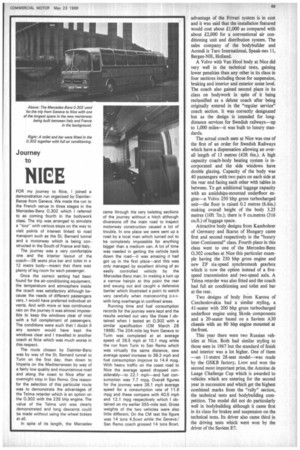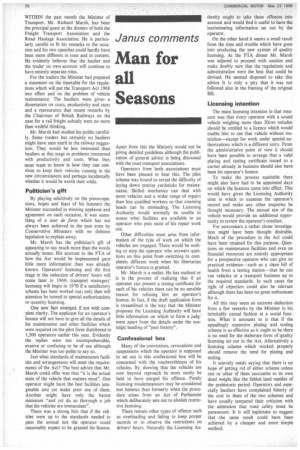J ourney to
Page 71

Page 72

If you've noticed an error in this article please click here to report it so we can fix it.
NIEE
FOR my journey to Nice, I mined a demonstration run organized by DaimlerBenze from Geneva. We made the run to the French venue in three stages in the Mercedes-Benz 0.302 which I referred to as coming fourth in the bodywork class. The trip was arranged to simulate a "tour" with various stops on the way to visit points of interest linked to road transport such as the St. Bernard tunnel and a motorway which is being constructed in the South of France and Italy.
The journey was a very comfortable one and the interior layout of the coach 38 seats plus bar and toilet in a 12 metre body—meant that there was plenty of leg room for each passenger.
Once the correct setting had been found for the air-conditioning equipment, the temperature and atmosphere inside the coach was satisfactory although because the needs of different passengers vary, I would have preferred individual air vents. And with more or less continuous rain on the journey it was almost impossible to keep the windows clear of mist with a full complement of passengers. The conditions were such that I doubt if any system would have kept the windows clear and I travelled in another coach at Nice which was much worse in this respect.
The route chosen by Daimler-Benz was by way of the St. Bernard tunnel to Turin on the first day, then down to Imperia on the Mediterranean by way of a fairly low quality and mountainous road and along the coast to Nice after an overnight stop in San Remo. One reason for the selection of this particular route was to demonstrate the advantages of the Telma retarder which is an option on the 0.302 with the 235 bhp engine. The value of the Telma unit was clearly demonstrated and long descents could be made without using the wheel brakes at all.
In spite of its length, the Mercedes came through the very twisting sections of the journey without a hitch although diversions off the main road to inspect motorway construction caused a lot of trouble. In one place we were sent up a road by a local man which turned out to be completely impossible for anything bigger than a medium van. A lot of time was needed in getting the vehicle back' down the road—it was amazing it had got up in the first place—and this was only managed by excellent driving of an easily controlled vehicle by the Mercedes-Benz man. In making a turn up a narrow hairpin at this point the rear end swung out and caught a defensive barrier which illustrated a point to watch very carefully when manoeuvring p.s.v. with long overhangs in confined areas.
Running time and fuel consumption records for the journey were kept and the results worked out very like those I obtained when I tested an 0.302 with a similar specification (CM March 28 1969), The 204-mile leg from Geneva to Turin was completed at an average speed of 36.5 mph at 10.1 mpg while the run from Turin to San Remo which was virtually the same distance, saw average speed increase to 38.3 mph and fuel consumption improve to 14.4 mpg. With heavy traffic on the coast road to Nice the average speed dropped considerably—to 22.1 mph—and fuel consumption was 7.7 mpg. Overall figures for the journey were 36.1 mph average speed for a consumption rate of 11.6 mpg and these compare with 40.5 mph and 12.1 mpg respectively which I obtained on my earlier 355-mile test. Gross weights of the two vehicles were also little different. On the CM test the figure was 14 tons 4.5cwt while the Geneva ,1 San Remo coach grossed 14 tons 8cwt.
advantage of the Frivari system is in cost and it was said that the installation featured would cost about £1,000 as compared with about £2,000 for a conventional air conditioning unit and distribution system. The sales company of the bodybuilder and Acondi is Taro International, Spaak-nes 11, Bergen-NH, Holland.
A Volvo with Van Hoot body at Nice did very well in the technical tests, gaining lower penalties than any other in its class in four sections including those for suspension, braking and interior and exterior noise level. The coach also gained second place in its class on bodywork in spite of it being reclassified as a deluxe coach after being originally entered in the "regular service" coach section. It was correctly designated but as the design is intended for longdistance services for Swedish railways—up to 1,000 miles—it was built to luxury standards.
The actual coach seen at Nice was one of the first of an order for Swedish Railways which have a dispensation allowing an overall length of 13 metres (42ft 6in.). A high capacity coach-body heating system is incorporated and the side windows have double glazing. Capacity of the body was 40 passengers with two pairs on each side at the rear end facing each other with tables in between. To get additional luggage capacity with an amidships-mounted underfloor engine—a Volvo 250 bhp gross turbocharged unit—the floor is raised 0.2 metres (6.6in.) making overall height of the body 3.25 metres (loft 7in.); there is 9 cu.metres (316 cu.ft.) of luggage space.
Attractive body designs from Kassbohrer of Germany and Ikarus of Hungary came first and second respectively in the "luxury inter-Continental" class. Fourth place in this class went to one of the Mercedes-Benz 0.302 coaches at Nice this particular example having the 230 bhp gross engine and new ZF six-speed synchromesh gearbox which is now the option instead of a fivespeed transmission and two-speed axle. A Telma retarder was also fitted and the coach had full air conditioning and toilet and bar at the rear.
Two designs of body from Karosa of Czechoslovakia had a similar styling, a 41-seater with 200 bhp gross turbocharged underfloor engine using Skoda components and a 20-seater based on a Saviem A30 chassis with an 80 bhp engine mounted at the front.
This year there were two Russian vehicles at Nice. Both had similar styling to those seen in 1967 but the standard of finish and interior was a lot higher. One of them —an 11-metre 28-seat model—was made by the GSKB factory, Lvov and won the second most important prize, the Antoine de Laage Challenge Cup which is awarded to vehicles which are entering for the second year in succession and which get the highest combined marks from the "rally" section, the technical tests and bodybuilding competition. The model did not do particularly well in bodybuilding although it came first in its class for brakes and suspension on the technical tests. Its driver also came third in the driving tests which were won by the driver of the Saviem E7.
WITHIN the past month the Minister of Transport, Mr. Richard Marsh, has been the principal guest at the dinners of both the Freight Transport Association and the Road Haulage Association. He is particularly careful to fit his remarks to the occasion and his two speeches could hardly have been more different in tone and in content. He evidently believes that the haulier and the trader on own-account will continue to have entirely separate roles.
For the traders the Minister had prepared a statement on the timetable for the regulations which will put the Transport Act 1968 into effect and on the problem of vehicle maintenance. The hauliers were given a dissertation on costs, productivity and rates and a reassurance that recent remarks by the Chairman of British Railways on the case for a rail freight subsidy were no more than wishful thinking.
Mr. Marsh had studied his public carefully. Some traders but certainly no hauliers might have seen merit in the railway suggestion. They would be less interested than hauliers at this stage in problems concerned with productivity and costs. What they most want to know is how they can continue to keep their vehicles running in the new circumstances and perhaps incidentally whether it would be worth their while.
Politician's gift By playing sele'ctively on the preoccupations, hopes and fears of his listeners the Minister succeeded in winning applause and agreement on each occasion. It was something of a lour de force which has not always been achieved in the past even by Conservative Ministers with no dubious legislation to explain away.
Mr. Marsh has the politician's gift of appearing to say much more than the words actually mean. His account to the FTA of how the Act would be implemented gave little more information than was already known. Operators' licensing and the first stage in the reduction of drivers' hours will come later in 1969; transport managers' licensing will begin in 1970 if a satisfactory scheme has been worked out; only then will attention be turned to special authorizations or quantity licensing.
One new fact emerged, if not with complete clarity. The applicant for an operator's licence will not have to give all the details of his maintenance and other facilities which were required on the pilot form distributed to 1,500 operators earlier this year. Evidently the replies were too incomprehensible, evasive or confusing to be of use although the Minister was too polite to say so.
Just what standards of maintenance facilities and arrangements will meet the requirements of the Act? The best advice that Mr. Marsh could offer was that "it is the actual state of the vehicle that matters most". One operator might have the best facilities imaginable and yet make poor use of them. Another might have only the barest minimum "and yet do so thorough a job that his vehicles are immaculate".
There was a strong hint that if the vehicles were up to the standards needed to pass the annual test the operator could reasonably expect to be granted his licence.
































































































































